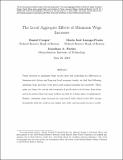| dc.contributor.author | COOPER, DANIEL | |
| dc.contributor.author | LUENGO-PRADO, MARÍA JOSÉ | |
| dc.contributor.author | PARKER, JONATHAN A | |
| dc.date.accessioned | 2021-10-27T20:04:58Z | |
| dc.date.available | 2021-10-27T20:04:58Z | |
| dc.date.issued | 2020 | |
| dc.identifier.uri | https://hdl.handle.net/1721.1/134429 | |
| dc.description.abstract | © 2019 The Ohio State University Using variation in minimum wages across cities and controlling for differences in business-cycle factors and long-run local economic trends, we find that following minimum wage increases, both, prices and nominal spending rise modestly. These gains are larger for certain subcategories of goods such as food away from home and in locations where low-wage workers account for a larger share of employment. Further, minimum wage increases are associated with reduced total debt among households with low credit scores, higher auto debt, and increased access to credit. | |
| dc.language.iso | en | |
| dc.publisher | Wiley | |
| dc.relation.isversionof | 10.1111/jmcb.12684 | |
| dc.rights | Creative Commons Attribution-Noncommercial-Share Alike | |
| dc.rights.uri | http://creativecommons.org/licenses/by-nc-sa/4.0/ | |
| dc.source | MIT web domain | |
| dc.title | The Local Aggregate Effects of Minimum Wage Increases | |
| dc.type | Article | |
| dc.contributor.department | Sloan School of Management | |
| dc.relation.journal | Journal of Money, Credit and Banking | |
| dc.eprint.version | Original manuscript | |
| dc.type.uri | http://purl.org/eprint/type/JournalArticle | |
| eprint.status | http://purl.org/eprint/status/NonPeerReviewed | |
| dc.date.updated | 2021-04-16T13:08:41Z | |
| dspace.orderedauthors | COOPER, D; LUENGO-PRADO, MJ; PARKER, JA | |
| dspace.date.submission | 2021-04-16T13:08:41Z | |
| mit.journal.volume | 52 | |
| mit.journal.issue | 1 | |
| mit.license | OPEN_ACCESS_POLICY | |
| mit.metadata.status | Authority Work and Publication Information Needed | |
